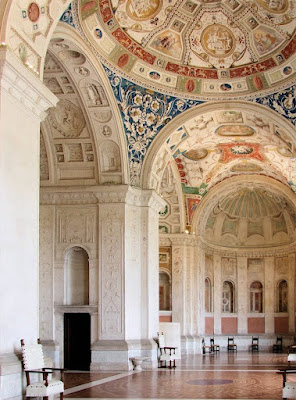The Domus Aurea, the Wonder of Antiquity in the Renaissance.
Grotesques in the Castel Sant'Angelo, Rome.
On a beautiful Roman day such as today, you might want to take a stroll down the Oppian Hill, where you can get amazing views over the Colosseum and the Forum. One of the first things that you might notice is the incredible number of derelict ancient ruins of what used to be colossal structures.
An interior view of the Domus Aurea.
On 18th July 64 A.D. started a terrible fire which destroyed most of the city, it went on for six days and six nights. According to legend, Emperor Nero witnessed the event from the top of the hill. It is here that he decided to have a giant palace built for him right there. The Domus Aurea as it became known, was a massive complex of marble-clad palaces, loggias and painted halls, enormous fountains and water games, immersed in over 200 hectares of luxurious gardens. It occupied most of the Oppian Hill and parts of the Palatine and Esquiline Hills. It was here that the emperor would hold his unending garden parties, among the marbles, vineyards, woods and fountains, decorated with hundreds of fine sculptures taken from Greece. He supervised its construction himself, Rome's citizens despised the palace, as everyone, in one way or another, contributed to its construction unwillingly. After his death, the Domus Aurea was gifted to the Roman citizens. Subsequently, demolition began under Vespasian. Following emperors turned the complex into baths, new residences, and finally in 104 what remained of it burnt down. Later, the remaining ruins were buried underneath a layer of sand which preserved it until its later rediscovery.
Grotesques in the Domus Aurea.
At the end of the 15th century, the Oppian Hill was at the edge of the city of Rome, bordering the countryside. It was then that a young man accidentally stepped into a hole in the ground and found himself in a grotto that was completely decorated in frescoes. The Renaissance was a period of rediscovery of antiquity in all its forms; politics, philosophy, literature and indeed art. Renaissance art and its appreciation for the classical order was greatly inspired by Rome. Soon, young artists started to visit the ruins of the Domus Aurea in order to take inspiration for their own masterpieces, among them were Pintoricchio, Michelangelo and Raphael.
Raphael's Grotesques in the Villa Madama, Rome.
The beautiful frescoes in the Domus Aurea were in the style that became known as Grotesques, the extravagant motifs and figures that characterized ancient Roman pictorial art. These were soon adopted all over Rome and Florence, and can be found in any frame of a 15th or 16th century panel or fresco. Among the most notable examples are those by Raphael in Rome. They also became prevalent in the Roman Mannerist style thanks to the School of Raphael through masters such as Perin del Vaga, Giulio Romano, the Zuccari brothers. (Mannerism was an eclectic continuation of Renaissance art in the mid-16th century). If you happen to be in Florence, Rome or anywhere else in central/northern Italy, have a good hunt down in churches, palaces and galleries and be inspired by this gorgeous revival of eccentric figures.
Mannerist Grotesques by Taddeo Zuccari.






